Analyzing Factors Affecting Emergency Department Stay Duration in NSW
VerifiedAdded on 2020/05/11
|19
|3393
|117
AI Summary
The assignment explores a dataset from New South Wales Health that tracks patient visits to emergency departments over two years. It focuses on identifying factors influencing patient stay durations using statistical methods like ANOVA and Kruskal-Wallis tests. Key findings indicate variability in mean stay times across different separation modes, visit types, and gender, suggesting targeted interventions could optimize department efficiency.
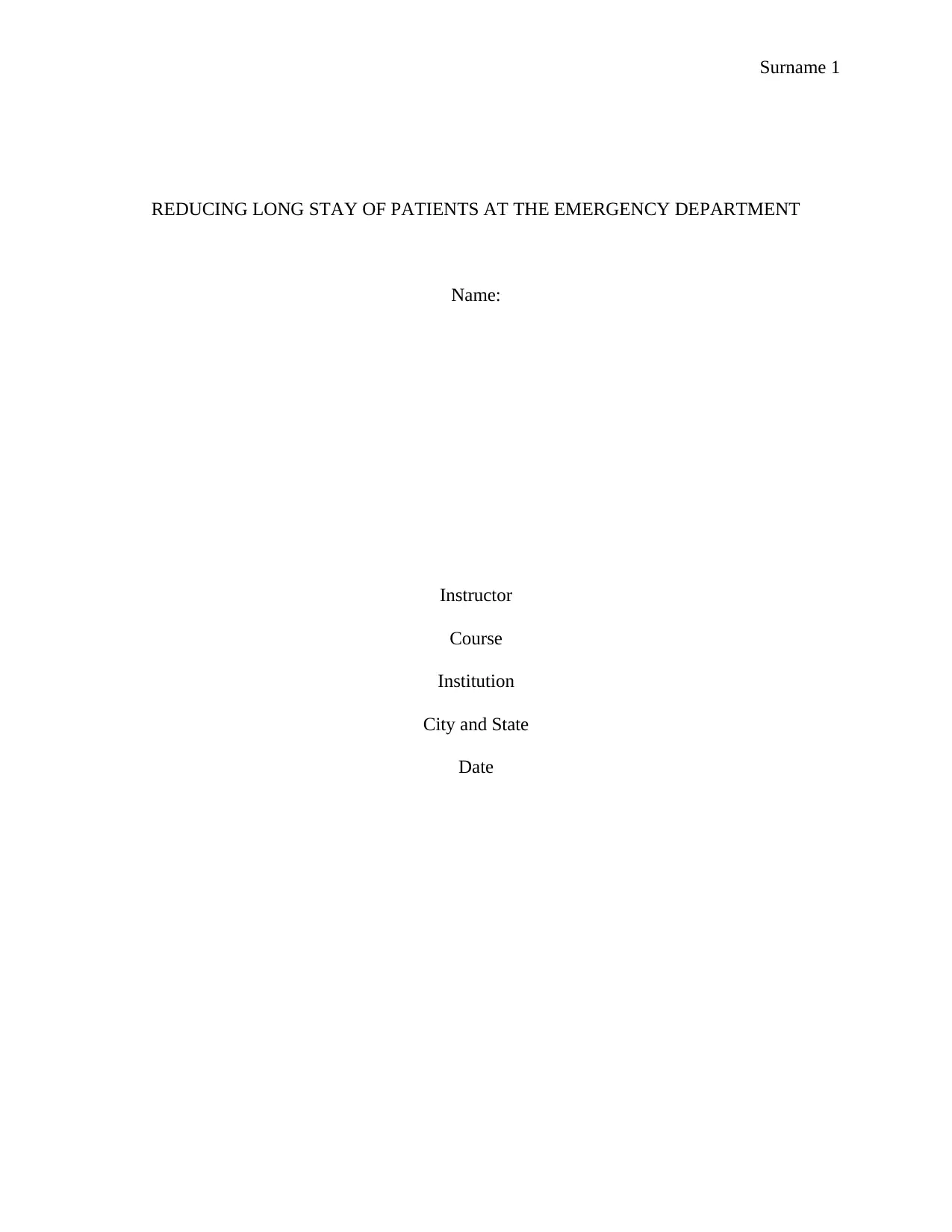
Surname 1
REDUCING LONG STAY OF PATIENTS AT THE EMERGENCY DEPARTMENT
Name:
Instructor
Course
Institution
City and State
Date
REDUCING LONG STAY OF PATIENTS AT THE EMERGENCY DEPARTMENT
Name:
Instructor
Course
Institution
City and State
Date
Paraphrase This Document
Need a fresh take? Get an instant paraphrase of this document with our AI Paraphraser
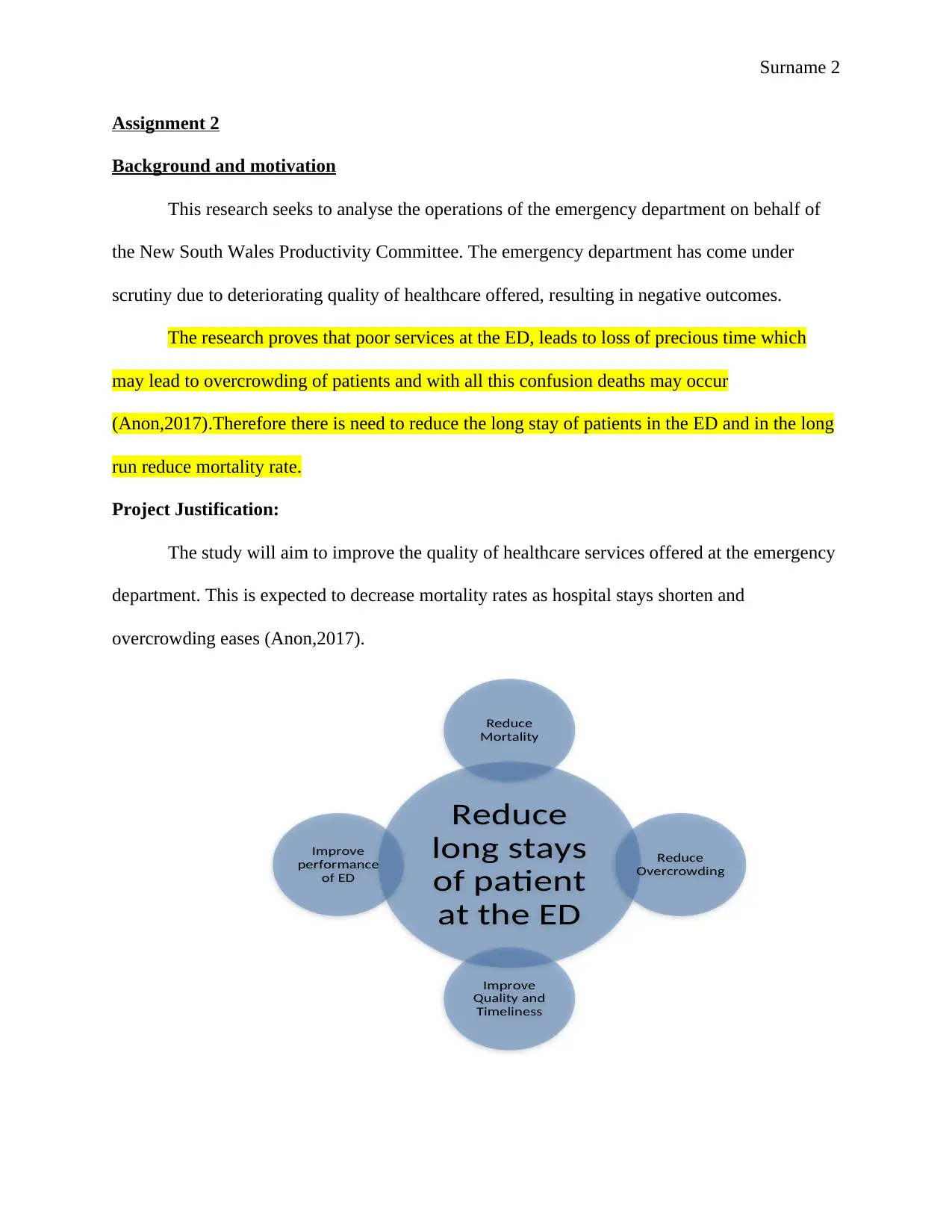
Surname 2
Assignment 2
Background and motivation
This research seeks to analyse the operations of the emergency department on behalf of
the New South Wales Productivity Committee. The emergency department has come under
scrutiny due to deteriorating quality of healthcare offered, resulting in negative outcomes.
The research proves that poor services at the ED, leads to loss of precious time which
may lead to overcrowding of patients and with all this confusion deaths may occur
(Anon,2017).Therefore there is need to reduce the long stay of patients in the ED and in the long
run reduce mortality rate.
Project Justification:
The study will aim to improve the quality of healthcare services offered at the emergency
department. This is expected to decrease mortality rates as hospital stays shorten and
overcrowding eases (Anon,2017).
Reduce
long stays
of patient
at the ED
Reduce
Mortality
Reduce
Overcrowding
Improve
Quality and
Timeliness
Improve
performance
of ED
Assignment 2
Background and motivation
This research seeks to analyse the operations of the emergency department on behalf of
the New South Wales Productivity Committee. The emergency department has come under
scrutiny due to deteriorating quality of healthcare offered, resulting in negative outcomes.
The research proves that poor services at the ED, leads to loss of precious time which
may lead to overcrowding of patients and with all this confusion deaths may occur
(Anon,2017).Therefore there is need to reduce the long stay of patients in the ED and in the long
run reduce mortality rate.
Project Justification:
The study will aim to improve the quality of healthcare services offered at the emergency
department. This is expected to decrease mortality rates as hospital stays shorten and
overcrowding eases (Anon,2017).
Reduce
long stays
of patient
at the ED
Reduce
Mortality
Reduce
Overcrowding
Improve
Quality and
Timeliness
Improve
performance
of ED
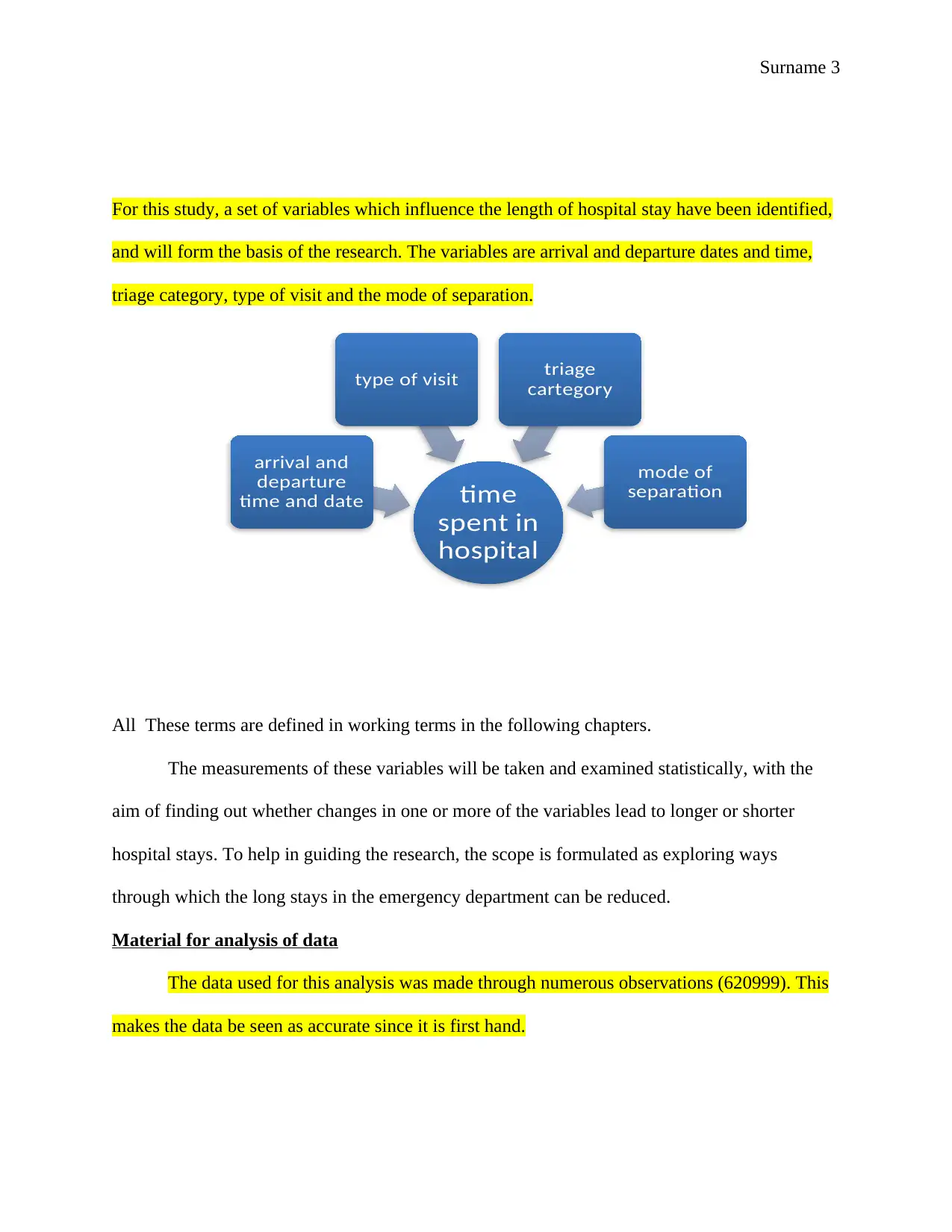
Surname 3
For this study, a set of variables which influence the length of hospital stay have been identified,
and will form the basis of the research. The variables are arrival and departure dates and time,
triage category, type of visit and the mode of separation.
All These terms are defined in working terms in the following chapters.
The measurements of these variables will be taken and examined statistically, with the
aim of finding out whether changes in one or more of the variables lead to longer or shorter
hospital stays. To help in guiding the research, the scope is formulated as exploring ways
through which the long stays in the emergency department can be reduced.
Material for analysis of data
The data used for this analysis was made through numerous observations (620999). This
makes the data be seen as accurate since it is first hand.
time
spent in
hospital
arrival and
departure
time and date
type of visit triage
cartegory
mode of
separation
For this study, a set of variables which influence the length of hospital stay have been identified,
and will form the basis of the research. The variables are arrival and departure dates and time,
triage category, type of visit and the mode of separation.
All These terms are defined in working terms in the following chapters.
The measurements of these variables will be taken and examined statistically, with the
aim of finding out whether changes in one or more of the variables lead to longer or shorter
hospital stays. To help in guiding the research, the scope is formulated as exploring ways
through which the long stays in the emergency department can be reduced.
Material for analysis of data
The data used for this analysis was made through numerous observations (620999). This
makes the data be seen as accurate since it is first hand.
time
spent in
hospital
arrival and
departure
time and date
type of visit triage
cartegory
mode of
separation
⊘ This is a preview!⊘
Do you want full access?
Subscribe today to unlock all pages.

Trusted by 1+ million students worldwide
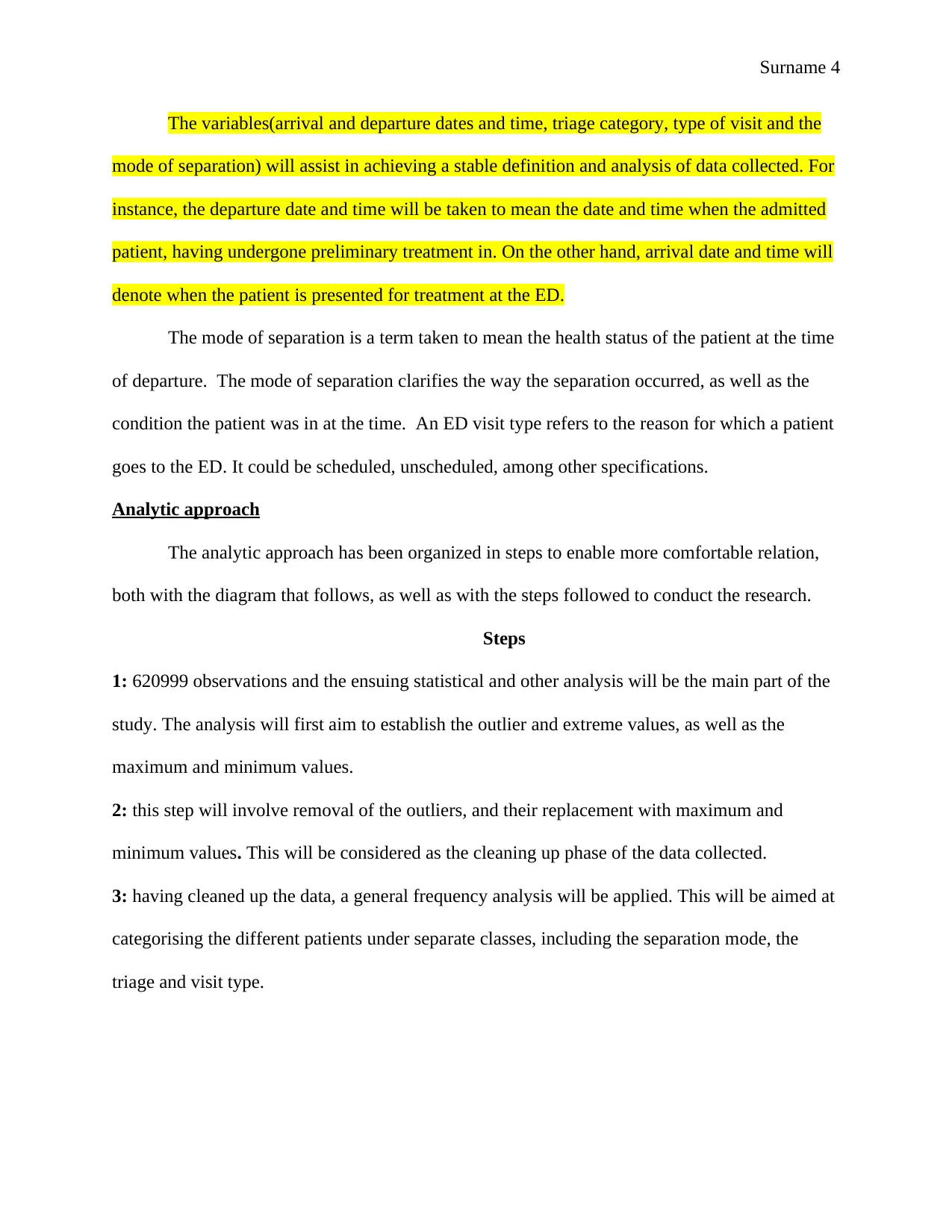
Surname 4
The variables(arrival and departure dates and time, triage category, type of visit and the
mode of separation) will assist in achieving a stable definition and analysis of data collected. For
instance, the departure date and time will be taken to mean the date and time when the admitted
patient, having undergone preliminary treatment in. On the other hand, arrival date and time will
denote when the patient is presented for treatment at the ED.
The mode of separation is a term taken to mean the health status of the patient at the time
of departure. The mode of separation clarifies the way the separation occurred, as well as the
condition the patient was in at the time. An ED visit type refers to the reason for which a patient
goes to the ED. It could be scheduled, unscheduled, among other specifications.
Analytic approach
The analytic approach has been organized in steps to enable more comfortable relation,
both with the diagram that follows, as well as with the steps followed to conduct the research.
Steps
1: 620999 observations and the ensuing statistical and other analysis will be the main part of the
study. The analysis will first aim to establish the outlier and extreme values, as well as the
maximum and minimum values.
2: this step will involve removal of the outliers, and their replacement with maximum and
minimum values. This will be considered as the cleaning up phase of the data collected.
3: having cleaned up the data, a general frequency analysis will be applied. This will be aimed at
categorising the different patients under separate classes, including the separation mode, the
triage and visit type.
The variables(arrival and departure dates and time, triage category, type of visit and the
mode of separation) will assist in achieving a stable definition and analysis of data collected. For
instance, the departure date and time will be taken to mean the date and time when the admitted
patient, having undergone preliminary treatment in. On the other hand, arrival date and time will
denote when the patient is presented for treatment at the ED.
The mode of separation is a term taken to mean the health status of the patient at the time
of departure. The mode of separation clarifies the way the separation occurred, as well as the
condition the patient was in at the time. An ED visit type refers to the reason for which a patient
goes to the ED. It could be scheduled, unscheduled, among other specifications.
Analytic approach
The analytic approach has been organized in steps to enable more comfortable relation,
both with the diagram that follows, as well as with the steps followed to conduct the research.
Steps
1: 620999 observations and the ensuing statistical and other analysis will be the main part of the
study. The analysis will first aim to establish the outlier and extreme values, as well as the
maximum and minimum values.
2: this step will involve removal of the outliers, and their replacement with maximum and
minimum values. This will be considered as the cleaning up phase of the data collected.
3: having cleaned up the data, a general frequency analysis will be applied. This will be aimed at
categorising the different patients under separate classes, including the separation mode, the
triage and visit type.
Paraphrase This Document
Need a fresh take? Get an instant paraphrase of this document with our AI Paraphraser
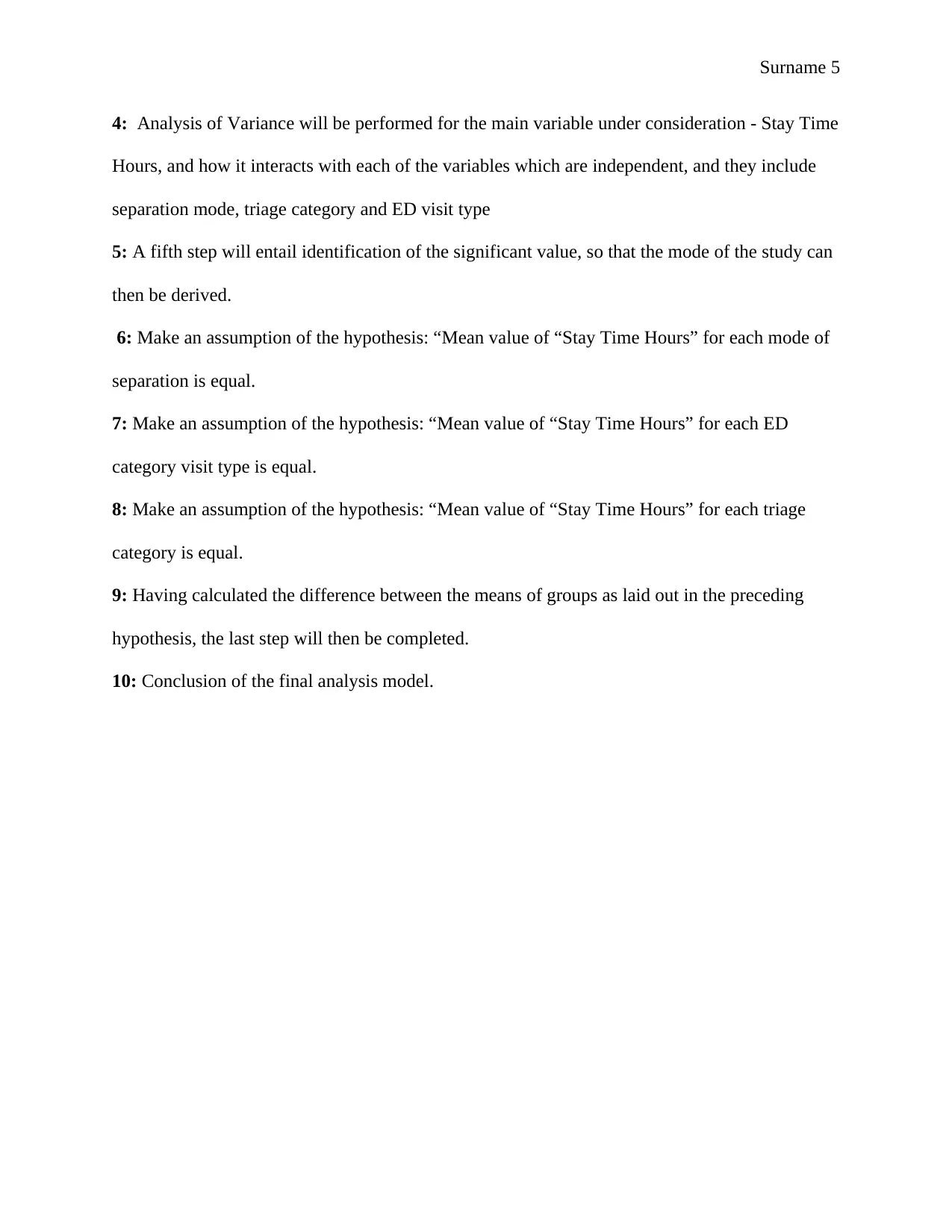
Surname 5
4: Analysis of Variance will be performed for the main variable under consideration - Stay Time
Hours, and how it interacts with each of the variables which are independent, and they include
separation mode, triage category and ED visit type
5: A fifth step will entail identification of the significant value, so that the mode of the study can
then be derived.
6: Make an assumption of the hypothesis: “Mean value of “Stay Time Hours” for each mode of
separation is equal.
7: Make an assumption of the hypothesis: “Mean value of “Stay Time Hours” for each ED
category visit type is equal.
8: Make an assumption of the hypothesis: “Mean value of “Stay Time Hours” for each triage
category is equal.
9: Having calculated the difference between the means of groups as laid out in the preceding
hypothesis, the last step will then be completed.
10: Conclusion of the final analysis model.
4: Analysis of Variance will be performed for the main variable under consideration - Stay Time
Hours, and how it interacts with each of the variables which are independent, and they include
separation mode, triage category and ED visit type
5: A fifth step will entail identification of the significant value, so that the mode of the study can
then be derived.
6: Make an assumption of the hypothesis: “Mean value of “Stay Time Hours” for each mode of
separation is equal.
7: Make an assumption of the hypothesis: “Mean value of “Stay Time Hours” for each ED
category visit type is equal.
8: Make an assumption of the hypothesis: “Mean value of “Stay Time Hours” for each triage
category is equal.
9: Having calculated the difference between the means of groups as laid out in the preceding
hypothesis, the last step will then be completed.
10: Conclusion of the final analysis model.

Surname 6
Findings
The data analysed revealed that 97.76% of the patients who visit the emergency room do
so because of visit type is equals to 1. The result in this case implies that the ED should target
them while to help bring down the length of stay.
Method of seperation
identification of extreme
values and outlier in the
present variable's dataset.
Get rid of the outliers and
remove the sets of data
while replacing the
outliers with both
minimum and maximum
values
Perform the general
analysis of frequency to
obtain the total
percentage of patients as
per the category.
Performing one – way
analysis of Variance for
variable
Find the significant value
Make an assumption of
the hypotheses of
Stay_Time_Hours’ mean
value for every category of
mode of separation is
equal.
: Make an assumption of
the hypotheses of
Stay_Time_Hours’ mean
value for every category of
the triage is equal.
Identify the significant
difference between the
groups' mean.
Findings
The data analysed revealed that 97.76% of the patients who visit the emergency room do
so because of visit type is equals to 1. The result in this case implies that the ED should target
them while to help bring down the length of stay.
Method of seperation
identification of extreme
values and outlier in the
present variable's dataset.
Get rid of the outliers and
remove the sets of data
while replacing the
outliers with both
minimum and maximum
values
Perform the general
analysis of frequency to
obtain the total
percentage of patients as
per the category.
Performing one – way
analysis of Variance for
variable
Find the significant value
Make an assumption of
the hypotheses of
Stay_Time_Hours’ mean
value for every category of
mode of separation is
equal.
: Make an assumption of
the hypotheses of
Stay_Time_Hours’ mean
value for every category of
the triage is equal.
Identify the significant
difference between the
groups' mean.
⊘ This is a preview!⊘
Do you want full access?
Subscribe today to unlock all pages.

Trusted by 1+ million students worldwide

Surname 7
Emergency department visitors
mode of seperation =4
mode of seperation -1
The results showed that 56% of emergency department visitors can be attributed to the
mode of separation=4, while 28.9% of the visitors are of method of separation-1. As in the
previous analysis, the study found that these people should also be targeted if the hospital is to
reduce the time of stay.
The details of the workings and the reasons for these implications are contained in the appendix.
Triage category
Emergency department visitors
triage=4
triage=1
Emergency department visitors
mode of seperation =4
mode of seperation -1
The results showed that 56% of emergency department visitors can be attributed to the
mode of separation=4, while 28.9% of the visitors are of method of separation-1. As in the
previous analysis, the study found that these people should also be targeted if the hospital is to
reduce the time of stay.
The details of the workings and the reasons for these implications are contained in the appendix.
Triage category
Emergency department visitors
triage=4
triage=1
Paraphrase This Document
Need a fresh take? Get an instant paraphrase of this document with our AI Paraphraser
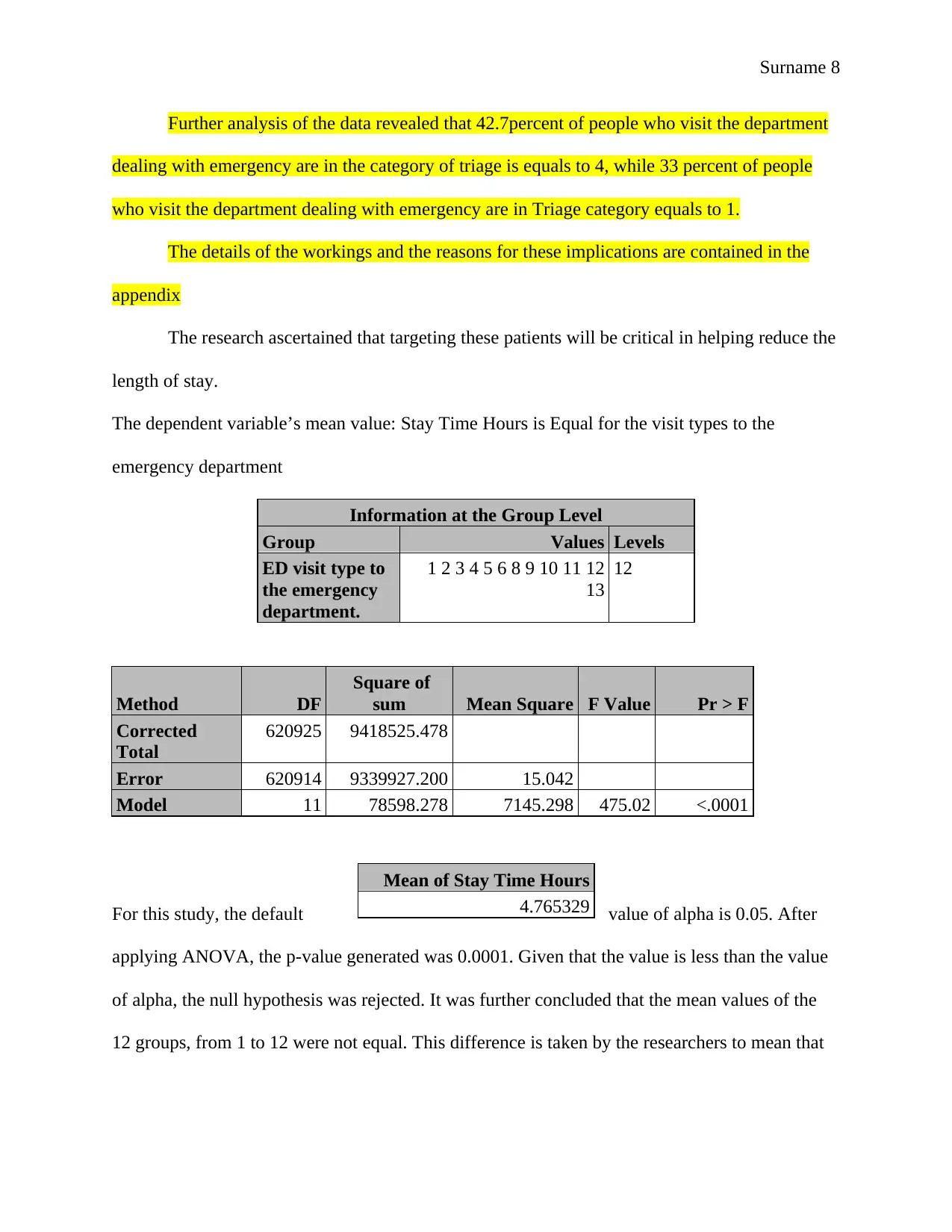
Surname 8
Further analysis of the data revealed that 42.7percent of people who visit the department
dealing with emergency are in the category of triage is equals to 4, while 33 percent of people
who visit the department dealing with emergency are in Triage category equals to 1.
The details of the workings and the reasons for these implications are contained in the
appendix
The research ascertained that targeting these patients will be critical in helping reduce the
length of stay.
The dependent variable’s mean value: Stay Time Hours is Equal for the visit types to the
emergency department
Information at the Group Level
Group Values Levels
ED visit type to
the emergency
department.
1 2 3 4 5 6 8 9 10 11 12
13
12
Method DF
Square of
sum Mean Square F Value Pr > F
Corrected
Total
620925 9418525.478
Error 620914 9339927.200 15.042
Model 11 78598.278 7145.298 475.02 <.0001
For this study, the default value of alpha is 0.05. After
applying ANOVA, the p-value generated was 0.0001. Given that the value is less than the value
of alpha, the null hypothesis was rejected. It was further concluded that the mean values of the
12 groups, from 1 to 12 were not equal. This difference is taken by the researchers to mean that
Mean of Stay Time Hours
4.765329
Further analysis of the data revealed that 42.7percent of people who visit the department
dealing with emergency are in the category of triage is equals to 4, while 33 percent of people
who visit the department dealing with emergency are in Triage category equals to 1.
The details of the workings and the reasons for these implications are contained in the
appendix
The research ascertained that targeting these patients will be critical in helping reduce the
length of stay.
The dependent variable’s mean value: Stay Time Hours is Equal for the visit types to the
emergency department
Information at the Group Level
Group Values Levels
ED visit type to
the emergency
department.
1 2 3 4 5 6 8 9 10 11 12
13
12
Method DF
Square of
sum Mean Square F Value Pr > F
Corrected
Total
620925 9418525.478
Error 620914 9339927.200 15.042
Model 11 78598.278 7145.298 475.02 <.0001
For this study, the default value of alpha is 0.05. After
applying ANOVA, the p-value generated was 0.0001. Given that the value is less than the value
of alpha, the null hypothesis was rejected. It was further concluded that the mean values of the
12 groups, from 1 to 12 were not equal. This difference is taken by the researchers to mean that
Mean of Stay Time Hours
4.765329
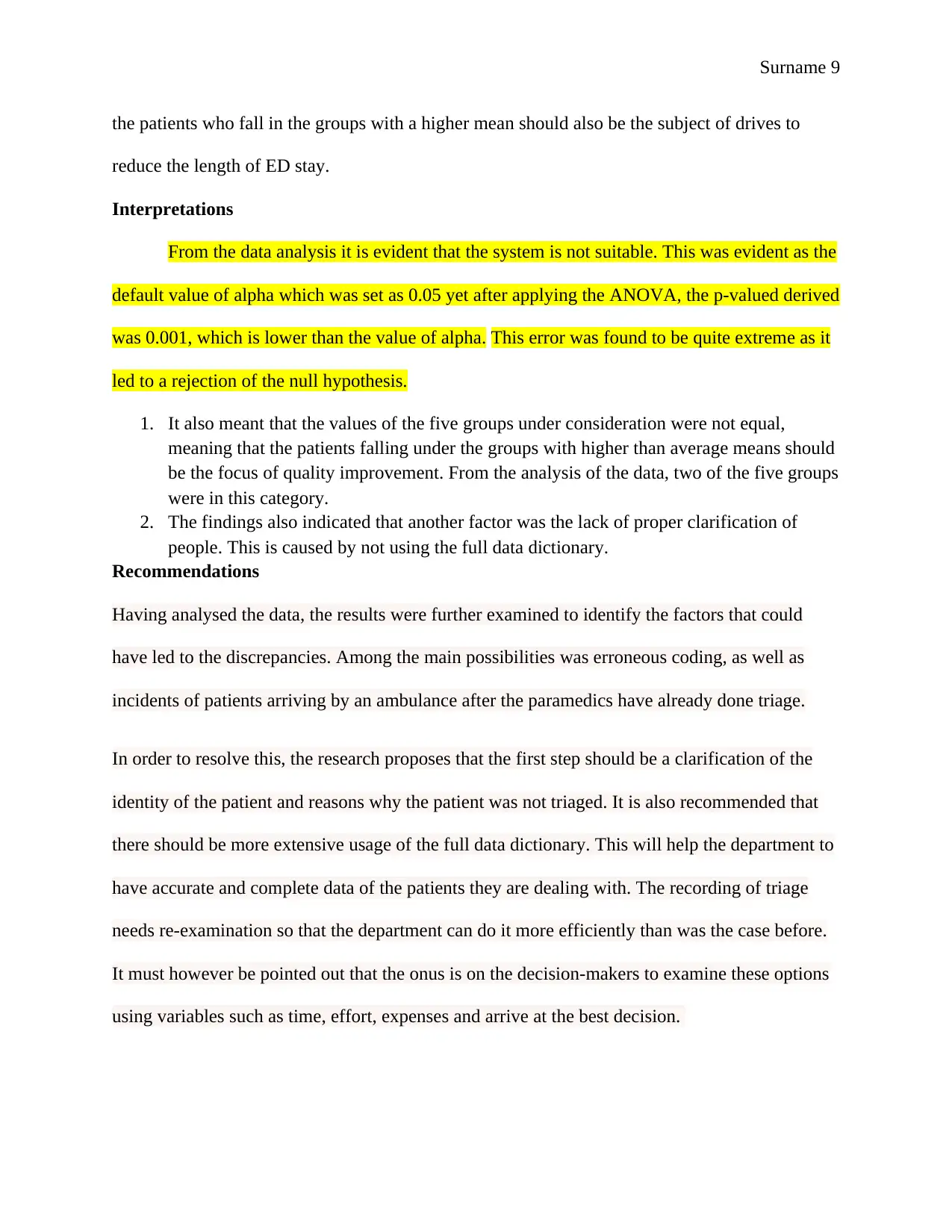
Surname 9
the patients who fall in the groups with a higher mean should also be the subject of drives to
reduce the length of ED stay.
Interpretations
From the data analysis it is evident that the system is not suitable. This was evident as the
default value of alpha which was set as 0.05 yet after applying the ANOVA, the p-valued derived
was 0.001, which is lower than the value of alpha. This error was found to be quite extreme as it
led to a rejection of the null hypothesis.
1. It also meant that the values of the five groups under consideration were not equal,
meaning that the patients falling under the groups with higher than average means should
be the focus of quality improvement. From the analysis of the data, two of the five groups
were in this category.
2. The findings also indicated that another factor was the lack of proper clarification of
people. This is caused by not using the full data dictionary.
Recommendations
Having analysed the data, the results were further examined to identify the factors that could
have led to the discrepancies. Among the main possibilities was erroneous coding, as well as
incidents of patients arriving by an ambulance after the paramedics have already done triage.
In order to resolve this, the research proposes that the first step should be a clarification of the
identity of the patient and reasons why the patient was not triaged. It is also recommended that
there should be more extensive usage of the full data dictionary. This will help the department to
have accurate and complete data of the patients they are dealing with. The recording of triage
needs re-examination so that the department can do it more efficiently than was the case before.
It must however be pointed out that the onus is on the decision-makers to examine these options
using variables such as time, effort, expenses and arrive at the best decision.
the patients who fall in the groups with a higher mean should also be the subject of drives to
reduce the length of ED stay.
Interpretations
From the data analysis it is evident that the system is not suitable. This was evident as the
default value of alpha which was set as 0.05 yet after applying the ANOVA, the p-valued derived
was 0.001, which is lower than the value of alpha. This error was found to be quite extreme as it
led to a rejection of the null hypothesis.
1. It also meant that the values of the five groups under consideration were not equal,
meaning that the patients falling under the groups with higher than average means should
be the focus of quality improvement. From the analysis of the data, two of the five groups
were in this category.
2. The findings also indicated that another factor was the lack of proper clarification of
people. This is caused by not using the full data dictionary.
Recommendations
Having analysed the data, the results were further examined to identify the factors that could
have led to the discrepancies. Among the main possibilities was erroneous coding, as well as
incidents of patients arriving by an ambulance after the paramedics have already done triage.
In order to resolve this, the research proposes that the first step should be a clarification of the
identity of the patient and reasons why the patient was not triaged. It is also recommended that
there should be more extensive usage of the full data dictionary. This will help the department to
have accurate and complete data of the patients they are dealing with. The recording of triage
needs re-examination so that the department can do it more efficiently than was the case before.
It must however be pointed out that the onus is on the decision-makers to examine these options
using variables such as time, effort, expenses and arrive at the best decision.
⊘ This is a preview!⊘
Do you want full access?
Subscribe today to unlock all pages.

Trusted by 1+ million students worldwide
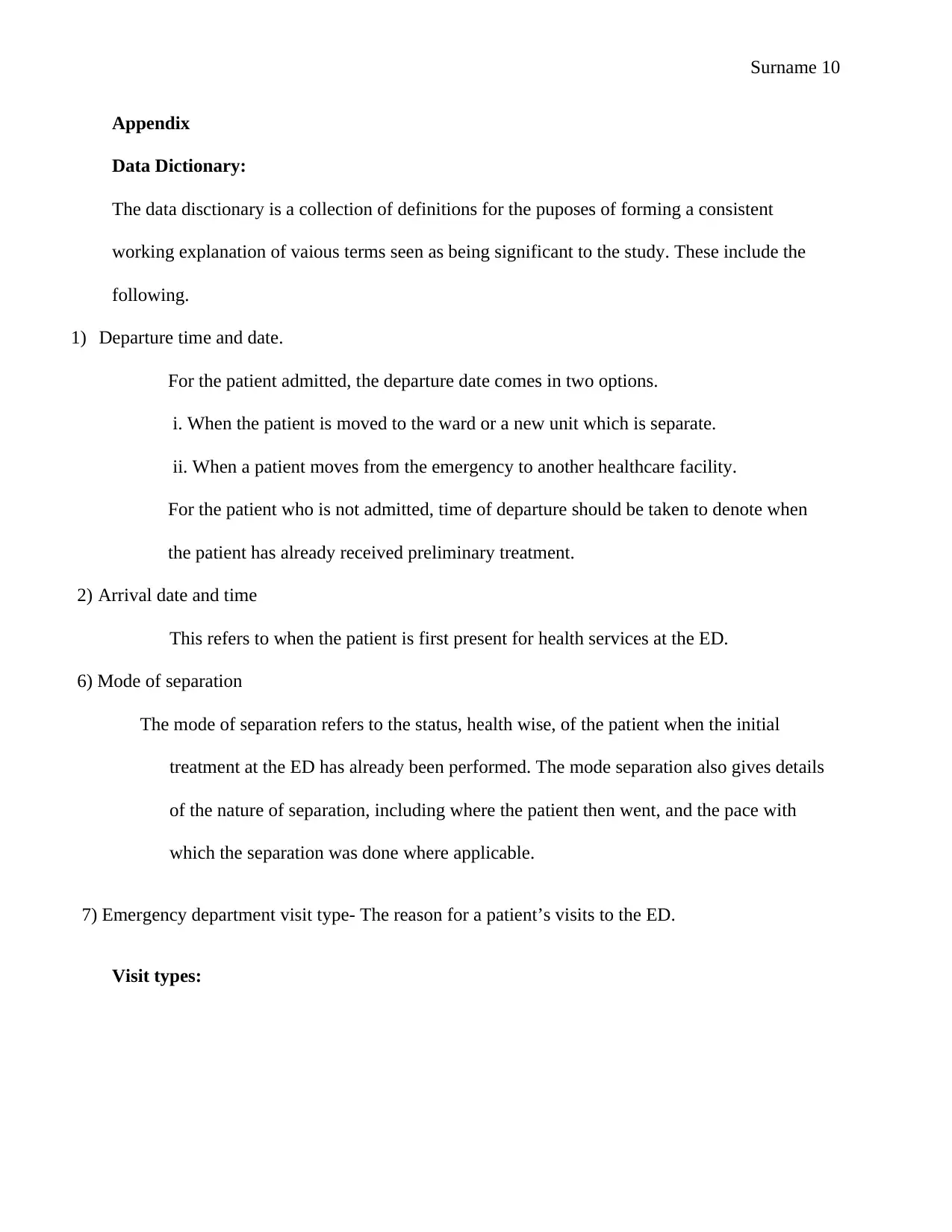
Surname 10
Appendix
Data Dictionary:
The data disctionary is a collection of definitions for the puposes of forming a consistent
working explanation of vaious terms seen as being significant to the study. These include the
following.
1) Departure time and date.
For the patient admitted, the departure date comes in two options.
i. When the patient is moved to the ward or a new unit which is separate.
ii. When a patient moves from the emergency to another healthcare facility.
For the patient who is not admitted, time of departure should be taken to denote when
the patient has already received preliminary treatment.
2) Arrival date and time
This refers to when the patient is first present for health services at the ED.
6) Mode of separation
The mode of separation refers to the status, health wise, of the patient when the initial
treatment at the ED has already been performed. The mode separation also gives details
of the nature of separation, including where the patient then went, and the pace with
which the separation was done where applicable.
7) Emergency department visit type- The reason for a patient’s visits to the ED.
Visit types:
Appendix
Data Dictionary:
The data disctionary is a collection of definitions for the puposes of forming a consistent
working explanation of vaious terms seen as being significant to the study. These include the
following.
1) Departure time and date.
For the patient admitted, the departure date comes in two options.
i. When the patient is moved to the ward or a new unit which is separate.
ii. When a patient moves from the emergency to another healthcare facility.
For the patient who is not admitted, time of departure should be taken to denote when
the patient has already received preliminary treatment.
2) Arrival date and time
This refers to when the patient is first present for health services at the ED.
6) Mode of separation
The mode of separation refers to the status, health wise, of the patient when the initial
treatment at the ED has already been performed. The mode separation also gives details
of the nature of separation, including where the patient then went, and the pace with
which the separation was done where applicable.
7) Emergency department visit type- The reason for a patient’s visits to the ED.
Visit types:
Paraphrase This Document
Need a fresh take? Get an instant paraphrase of this document with our AI Paraphraser
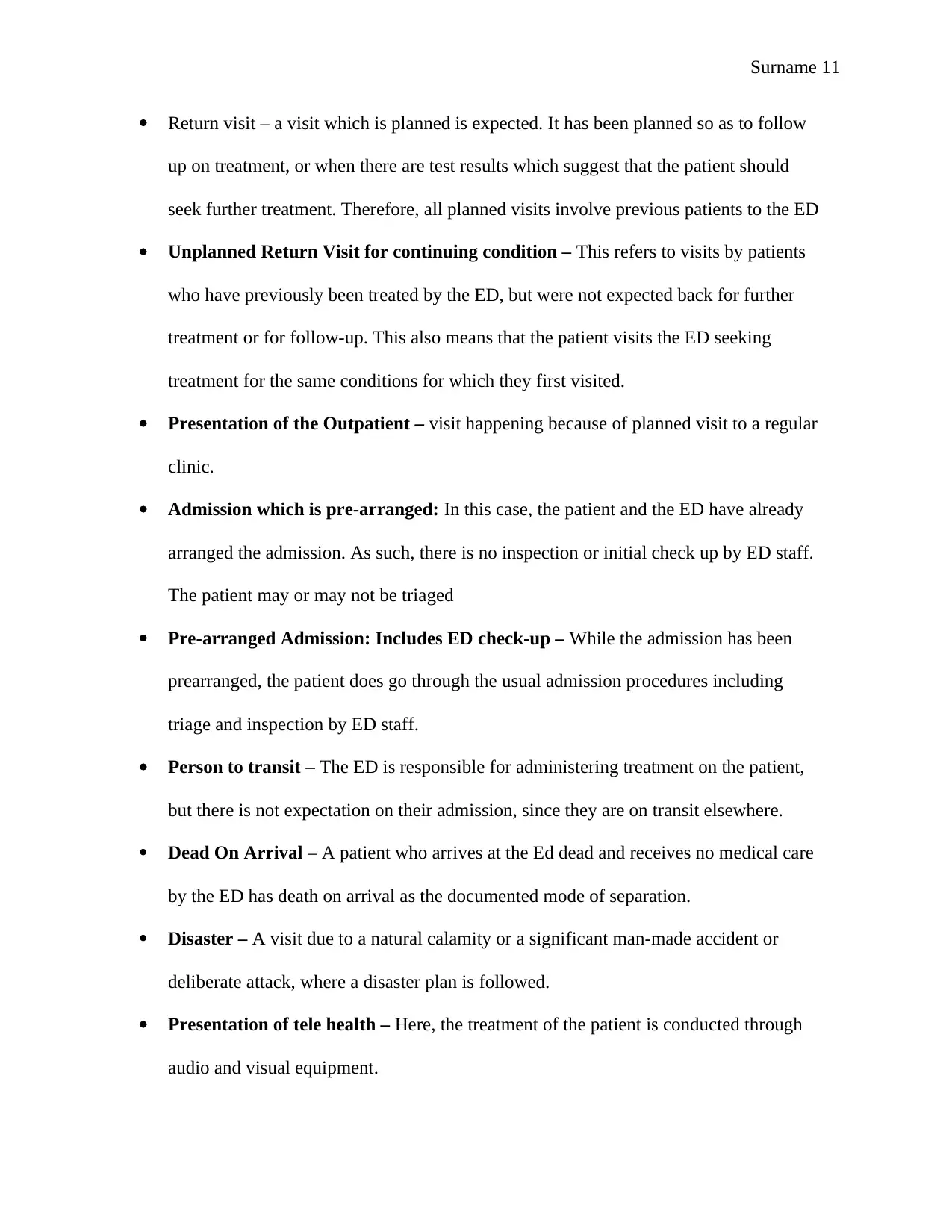
Surname 11
Return visit – a visit which is planned is expected. It has been planned so as to follow
up on treatment, or when there are test results which suggest that the patient should
seek further treatment. Therefore, all planned visits involve previous patients to the ED
Unplanned Return Visit for continuing condition – This refers to visits by patients
who have previously been treated by the ED, but were not expected back for further
treatment or for follow-up. This also means that the patient visits the ED seeking
treatment for the same conditions for which they first visited.
Presentation of the Outpatient – visit happening because of planned visit to a regular
clinic.
Admission which is pre-arranged: In this case, the patient and the ED have already
arranged the admission. As such, there is no inspection or initial check up by ED staff.
The patient may or may not be triaged
Pre-arranged Admission: Includes ED check-up – While the admission has been
prearranged, the patient does go through the usual admission procedures including
triage and inspection by ED staff.
Person to transit – The ED is responsible for administering treatment on the patient,
but there is not expectation on their admission, since they are on transit elsewhere.
Dead On Arrival – A patient who arrives at the Ed dead and receives no medical care
by the ED has death on arrival as the documented mode of separation.
Disaster – A visit due to a natural calamity or a significant man-made accident or
deliberate attack, where a disaster plan is followed.
Presentation of tele health – Here, the treatment of the patient is conducted through
audio and visual equipment.
Return visit – a visit which is planned is expected. It has been planned so as to follow
up on treatment, or when there are test results which suggest that the patient should
seek further treatment. Therefore, all planned visits involve previous patients to the ED
Unplanned Return Visit for continuing condition – This refers to visits by patients
who have previously been treated by the ED, but were not expected back for further
treatment or for follow-up. This also means that the patient visits the ED seeking
treatment for the same conditions for which they first visited.
Presentation of the Outpatient – visit happening because of planned visit to a regular
clinic.
Admission which is pre-arranged: In this case, the patient and the ED have already
arranged the admission. As such, there is no inspection or initial check up by ED staff.
The patient may or may not be triaged
Pre-arranged Admission: Includes ED check-up – While the admission has been
prearranged, the patient does go through the usual admission procedures including
triage and inspection by ED staff.
Person to transit – The ED is responsible for administering treatment on the patient,
but there is not expectation on their admission, since they are on transit elsewhere.
Dead On Arrival – A patient who arrives at the Ed dead and receives no medical care
by the ED has death on arrival as the documented mode of separation.
Disaster – A visit due to a natural calamity or a significant man-made accident or
deliberate attack, where a disaster plan is followed.
Presentation of tele health – Here, the treatment of the patient is conducted through
audio and visual equipment.
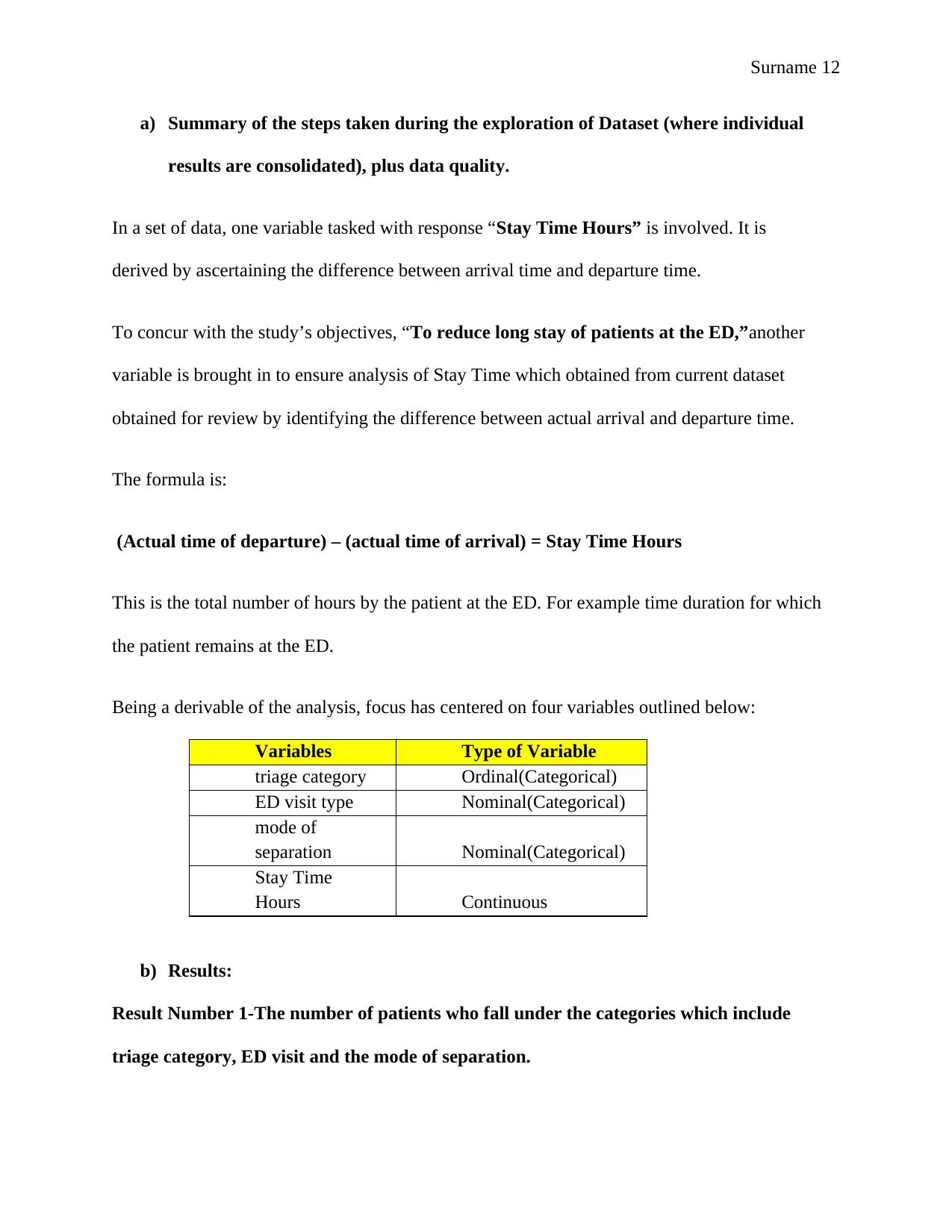
Surname 12
a) Summary of the steps taken during the exploration of Dataset (where individual
results are consolidated), plus data quality.
In a set of data, one variable tasked with response “Stay Time Hours” is involved. It is
derived by ascertaining the difference between arrival time and departure time.
To concur with the study’s objectives, “To reduce long stay of patients at the ED,”another
variable is brought in to ensure analysis of Stay Time which obtained from current dataset
obtained for review by identifying the difference between actual arrival and departure time.
The formula is:
(Actual time of departure) – (actual time of arrival) = Stay Time Hours
This is the total number of hours by the patient at the ED. For example time duration for which
the patient remains at the ED.
Being a derivable of the analysis, focus has centered on four variables outlined below:
Variables Type of Variable
triage category Ordinal(Categorical)
ED visit type Nominal(Categorical)
mode of
separation Nominal(Categorical)
Stay Time
Hours Continuous
b) Results:
Result Number 1-The number of patients who fall under the categories which include
triage category, ED visit and the mode of separation.
a) Summary of the steps taken during the exploration of Dataset (where individual
results are consolidated), plus data quality.
In a set of data, one variable tasked with response “Stay Time Hours” is involved. It is
derived by ascertaining the difference between arrival time and departure time.
To concur with the study’s objectives, “To reduce long stay of patients at the ED,”another
variable is brought in to ensure analysis of Stay Time which obtained from current dataset
obtained for review by identifying the difference between actual arrival and departure time.
The formula is:
(Actual time of departure) – (actual time of arrival) = Stay Time Hours
This is the total number of hours by the patient at the ED. For example time duration for which
the patient remains at the ED.
Being a derivable of the analysis, focus has centered on four variables outlined below:
Variables Type of Variable
triage category Ordinal(Categorical)
ED visit type Nominal(Categorical)
mode of
separation Nominal(Categorical)
Stay Time
Hours Continuous
b) Results:
Result Number 1-The number of patients who fall under the categories which include
triage category, ED visit and the mode of separation.
⊘ This is a preview!⊘
Do you want full access?
Subscribe today to unlock all pages.

Trusted by 1+ million students worldwide
1 out of 19